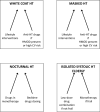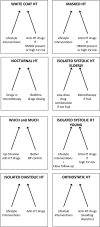Diagnostic and Therapeutic Approach to Different Hypertensive Phenotypes According to the 2023 ESH Guidelines
- PMID: 40244524
- PMCID: PMC12098205
- DOI: 10.1007/s40292-025-00716-x
Diagnostic and Therapeutic Approach to Different Hypertensive Phenotypes According to the 2023 ESH Guidelines
Abstract
The European Society of Hypertension (ESH) in the guidelines document issued in 2023 made specific recommendations regarding the diagnostic and therapeutic approach for the different hypertensive phenotypes detectable in current clinical practice. The present paper will offer a critical review of these recommendations.The clinical hypertensive phenotypes of most frequent detection in current clinical practice, namely white-coat hypertension, masked hypertension, nocturnal hypertension and isolated systolic hypertension of the elderly will be reviewed. Other less common phenotypes will be also addressed. Recommendations for each clinical phenotype are made, emphasizing the need for an accurate diagnosis and treatment for specific clinical conditions, i.e. when target organ damage and/or high cardiovascular risk is detected. Areas of uncertainty related to clinical phenotypes in which pathophysiological and prognostic information are still lacking will be discussed. Future studies will allow to refine the guidelines recommendations, particularly for the clinical conditions for which pathophysiological and prognostic information are at present scanty.
Keywords: Antihypertensive treatment; Guidelines; Hypertensive phenotypes; Isolated systolic hypertension; Nocturnal hypertension; White-coat hypertension.
© 2025. The Author(s).
Conflict of interest statement
Declarations. Conflict of interest: The authors declare no conflicts of interest.
Figures


Similar articles
-
Blood Pressure Measurement and Treatment Decisions.Circ Res. 2019 Mar 29;124(7):990-1008. doi: 10.1161/CIRCRESAHA.118.313219. Circ Res. 2019. PMID: 30920932 Review.
-
Diagnosis and management of patients with white-coat and masked hypertension.Nat Rev Cardiol. 2011 Aug 9;8(12):686-93. doi: 10.1038/nrcardio.2011.115. Nat Rev Cardiol. 2011. PMID: 21826071 Review.
-
Prognosis of Masked and White Coat Uncontrolled Hypertension Detected by Ambulatory Blood Pressure Monitoring in Elderly Treated Hypertensive Patients.Am J Hypertens. 2017 Nov 1;30(11):1106-1111. doi: 10.1093/ajh/hpx104. Am J Hypertens. 2017. PMID: 29059303
-
Home Blood Pressure-guided Anticipation Management of Hypertension: Effective to the Gap Between the Guidelines and the Individualized Medicine.Curr Hypertens Rev. 2019;15(1):2-6. doi: 10.2174/157340211501190129144223. Curr Hypertens Rev. 2019. PMID: 30729893 Review.
-
Ambulatory Blood Pressure Monitoring in the Diagnosis and Treatment of Hypertension.Adv Exp Med Biol. 2017;956:109-116. doi: 10.1007/5584_2016_177. Adv Exp Med Biol. 2017. PMID: 27981433 Review.
References
-
- Mancia G, Kreutz R, Brunström M, et al. 2023 ESH guidelines for the management of arterial hypertension. J Hypertens. 2023;41:1874–2071. - PubMed
-
- Mancia G, Facchetti R, Cuspidi C, Bombelli M, Corrao G, Grassi G. Limited reproducibility of MUCH and WUCH: evidence from the ELSA study. Eur Heart J. 2020;41:1565–71. - PubMed
-
- Pickering TG, James GD, Boddie G, Harshfield GA, Blank S, Laragh JH. How common is white-coat hypertension? JAMA. 1988;259:225–8. - PubMed
-
- Dolan E, Stanton A, Atkins N. Determinants of white-coat hypertension. Blood Press Monit. 2004;9:307–9. - PubMed
Publication types
MeSH terms
Substances
LinkOut - more resources
Full Text Sources
Medical

